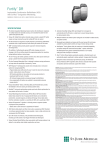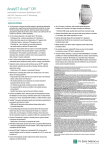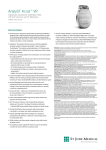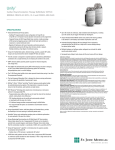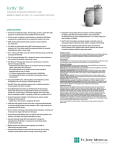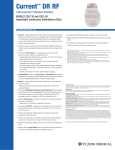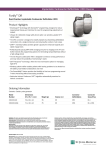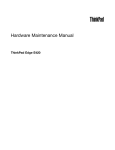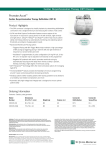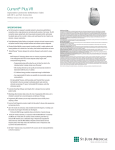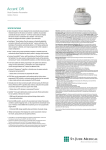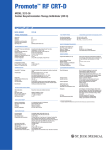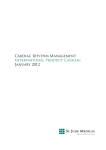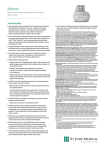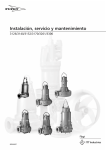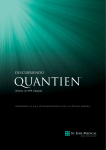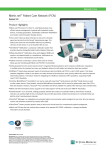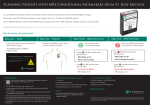Download Fortify™ VR - Sante International SA
Transcript
Fortify™ VR Implantable Cardioverter Defibrillator (ICD) with CorVue™ Congestion Monitoring MODELS CD1233-40 AND CD1233-40Q Specifications The CorVue Congestion Monitoring feature monitors the intrathoracic impedance in multiple vectors for improved accuracy, and it provides the option for both patient and physician alerts. Unique 40 J Safety Shock option, delivered energy, provides a greater DFT safety margin and may minimise the need for multiple DFT tests at implant. The SJ4 connector is designed to simplify implants by streamlining defibrillation connections into a single terminal pin and reducing the number of set screws. QHR™ chemistry battery provides greater capacity for enhanced longevity and charge times. The addition of antitachycardia pacing (ATP) while charging and prior to charging in the VF zone further extends the programming options for converting tachyarrhythmias before or during charge. The % V-Pacing alert notifies patients and their clinics when percent ventricular pacing is greater than the programmed threshold. The Low Frequency Attenuation filter is designed to enhance sensing performance and may reduce the possibility of oversensing T waves. DeFT Response™ technology tools provide more clinically proven, noninvasive options for managing high DFTs. – Programmable pulse widths allow the user to tailor the shock to the individual patient, making shocks more efficacious.1 – SVC shocking electrode can be quickly and noninvasively activated or deactivated with the touch of a button. – 40 J delivered energy provides unsurpassed energy for defibrillation. – Four programmable tilt options are available to accommodate variances among patients.2 Unique SenseAbility™ feature, with Decay Delay and Threshold Start, provides the flexibility to fine-tune sensing to individual patient needs. Unique Morphology Discrimination SVT discrimination feature helps reduce the risk of inappropriate ICD shocks and is intended to promote fast, accurate diagnosis and delivery of therapy. Up to 45 minutes of continuous, fully annotated stored electrograms, including up to 60 seconds of pre-trigger information per electrogram. Unique Vibratory Patient Notifier allows even patients with hearing problems to be alerted to a low battery, lead-related complications and more. Automatic Daily High-Voltage (HV) Lead Integrity Test is designed to automatically test the HV lead on a daily basis to ensure therapy delivery for optimal patient safety. Multiple hardware and software system safeguards are included for added security and patient comfort. AutoCapture™ Pacing System offers the maximum in threshold adaptability and patient safety with ventricular Beat-by-Beat™ capture confirmation. The AutoCapture Pacing System automatically delivers a 5,0 V backup safety pulse when noncapture is detected. Decreased device footprint and volume with the most narrow (40 mm) design available for greater patient comfort and range of motion during activity. Indications: The devices are intended to provide ventricular antitachycardia pacing and ventricular defibrillation for automated treatment of life-threatening ventricular arrhythmias. Contraindications: Contraindications for use of the pulse generator system include ventricular tachyarrhythmias resulting from transient or correctable factors such as drug toxicity, electrolyte imbalance, or acute myocardial infarction. Warnings and Precautions: Implantation Procedure. The physician should be familiar with all components of the system and the material in this manual before beginning the procedure. Ensure that a separate standby external defibrillator is immediately available. Implant the pulse generator no deeper than 5 cm to ensure reliable data transmission. For patient comfort, do not implant the pulse generator within 1,25 cm of bone unless you cannot avoid it. Device Replacement. Replace the pulse generator within three months of reaching the ERI indication. Replace the pulse generator immediately upon reaching ERI if there is frequent high-voltage charging and/or one or more of the pacing outputs are programmed above 2,5 V. Battery Incineration. Do not incinerate pulse generators as they contain sealed chemical power cells and capacitors that may explode. Return explanted devices to St. Jude Medical. High-Voltage Can. Ensure that tachyarrhythmia therapy is programmed Off before handling the pulse generator to avoid any risk of accidental shock. Do not program tachyarrhythmia therapies On until the pulse generator is inserted in the pocket. For effective defibrillation, perform all defibrillation testing with the can in the pocket. Magnetic Resonance Imaging (MRI). Avoid MRI devices because of the magnitude of the magnetic fields and the strength of the radiofrequency (RF) fields they produce. Device Storage. Store the pulse generator at temperatures between 10° and 45°C. Do not subject it to temperatures below -20° or over 60°C. After cold storage, allow the device to reach room temperature before charging the capacitors, programming, or implanting the device because cold temperature may affect initial device function. Device Communication. Communication with the device can be affected by electrical interference and strong magnetic fields. If this is a problem, turn off nearby electrical equipment or move it away from the patient and the programmer. If the problem persists, contact St. Jude Medical. Lead Impedance. Do not implant the pulse generator if the acute defibrillation lead impedance is less than 20 ohms or the lead impedance of chronic leads is less than 15 ohms. Damage to the device may result if highvoltage therapy is delivered into an impedance less than 15 ohms. Suboptimal RF Communication. The Merlin™ Patient Care System (PCS) indicates the quality of the RF communication by the telemetry strength indicator LEDs on both the programmer and the Merlin Antenna. Disconnecting Leads. Connecting or disconnecting sense/pace leads can produce electrical artifacts that can be sensed by the pulse generator. To prevent detection of artifacts, reprogram the pulse generator to tachyarrhythmia therapy Off: before disconnecting the leads from a pulse generator in the operating room; before a post-mortem examination; whenever there are no leads connected to it; when sense/pace leads are connected but are not implanted in a patient. If a programmer is not available, use a magnet to prevent delivery of tachyarrhythmia therapy in response to detected disconnection artifacts. Place the magnet over the pulse generator before disconnecting the leads. Do not remove it until the leads are reconnected. External Equipment for Arrhythmia Induction. If external equipment is used for arrhythmia induction through the pulse generator header and leads, apply rectified AC current through the high-voltage ports, not the sense/ pace ports, to avoid damaging the sense/pace function: disconnect the external equipment from the pulse generator before any therapy is delivered; otherwise, damage to the device is likely to occur. Place a magnet over the device until the external equipment can be disconnected. Adverse Events: Implantation of the pulse generator system, like that of any other device, involves risks, some possibly life-threatening. These include but are not limited to the following: acute hemorrhage/bleeding, air emboli, arrhythmia acceleration, cardiac or venous perforation, cardiogenic shock, cyst formation, erosion, exacerbation of heart failure, extrusion, fibrotic tissue growth, fluid accumulation, hematoma formation, histotoxic reactions, infection, keloid formation, myocardial irritability, nerve damage, pneumothorax, thromboemboli, venous occlusion. Other possible adverse effects include mortality due to: component failure, device-programmer communication failure, lead abrasion, lead dislodgment or poor lead placement, lead fracture, inability to defibrillate, inhibited therapy for a ventricular tachycardia, interruption of function due to electrical or magnetic interference, shunting of energy from defibrillation paddles, system failure due to ionising radiation. Other possible adverse effects include mortality due to inappropriate delivery of therapy caused by: multiple counting of cardiac events including T waves, P waves, or supplemental pacemaker stimuli. Among the psychological effects of device implantation are imagined pulsing, dependency, fear of inappropriate pulsing, and fear of losing pulse capability. Refer to the User’s Manual for detailed indications, contraindications, warnings, precautions and potential adverse events. Post-Therapy Pacing (independently programmable from Bradycardia and ATP) PHYSICAL SPECIFICATIONS Models Telemetry Delivered/Stored Energy (J) Volume (cc) Weight (g) Size (mm) Defibrillation Lead Connections Sense/Pace Lead Connections High-Voltage Can CD1233-40 RF 40/45 35 76 73 x 40 x 14 DF-1 IS-1 Electrically active titanium can PARAMETERS Settings CD1233-40Q RF 40/45 35 75 71 x 40 x 14 SJ4 SJ4 Electrically active titanium can Automatic Sensitivity Control adjustment for ventricular events On; Off (Post-Sensed; Ventricular) 50; 62,5; 75; 100%; (Post-Paced; Ventricular) Auto; 0,2-3,0 mV (Post-Sensed/Post-Paced; Ventricular) 0-220 125; 157 VT-1; VT-2; VF Sudden Onset; Interval Stability; Morphology Discrimination (MD) with Manual or Automatic Template Update Continuous sensing during charging Antitachycardia Pacing Therapy ATP Configurations ATP in VF Zone ATP Upper Rate Cutoff Burst Cycle Length Min. Burst Cycle Length (ms) Number of Bursts Number of Stimuli Add Stimuli per Burst ATP Pulse Amplitude (V) ATP Pulse Width (ms) Ramp; Burst; Scan; 1 or 2 schemes per VT zone ATP While Charging; ATP Prior to Charging; Off 150-300 bpm Adaptive; Readaptive or Fixed 150-400 in increments of 5 1-15 2-20 On; Off 7,5 independent from Bradycardia and Post-Therapy Pacing 1,0 or 1,5 independently programmable from Bradycardia and Post-Therapy Pacing High-Voltage Therapy High-Voltage Output Mode Waveform RV Polarity Electrode Configuration Fixed Pulse Width; Fixed Tilt Biphasic; Monophasic Cathode (-); Anode (+) RV to Can; RV to SVC/Can Atrial Fibrillation Device Testing/Induction Methods DC Fibber™ Pulse Duration (sec) Burst Fibber Cycle Length (ms) Noninvasive Programmed Stimulation (NIPS) 0,5-5,0 20-100 2-25 stimuli with up to 3 extrastimuli Programmable Notifiers (On; Off) Device Parameter Reset Entry into Backup VVI Mode Vibration Duration (sec) Number of Vibrations per Notification Number of Notifications Time Between Notifications (hours) Device at ERI; Charge Time Limit Reached; Possible HV Circuit Damage; Ventricular Lead Impedance Out of Range; High-Voltage Lead Impedance Out of Range; %V Pacing; CorVue™ Congestion Trigger On On 2; 4; 6; 8; 10; 12; 14; 16 2 1-16 10; 22 Electrograms and Diagnostics Stored Electrograms Therapy Summary Episodes Summary Lifetime Diagnostics Ventricular HV Lead Impedance Trend Histograms Real-Time Measurements (RTM) CorVue Congestion Monitoring CorVue Congestion Trigger Up to 45 minutes including up to 1 minute programmable pre-trigger data per VT/VF diagnosis/detection electrograms; triggers include: diagnosis; therapy; PC shock delivery; noise reversion; magnet reversion; and morphology template verification Diagram of therapies delivered Directory listing of up to 60 episodes with access to more details including stored electrograms History of bradycardia events and device-initiated charging Multi-Vector Trend Data Event Histogram; Ventricular Heart Rate Histogram; Exercise and Activity Trending Pacing lead impedances; high-voltage lead impedances; and signal amplitudes On; Off 8-18 days 1. Mouchawar G, Kroll M, Val-Mejias JE et al. ICD waveform optimization: a randomized prospective, pair-sampled multicenter study. PACE 2000;23 (Part II):1992-1995. 2. Sweeney MO, Natale A, Volosin KJ et al. Prospective randomized comparison of 50%/50% versus 65%/65% tilt biphasic waveform on defibrillation in humans. PACE 2001;24:60-65. Bradycardia Pacing Permanent Modes Temporary Modes Rate-Adaptive Sensor Programmable Rate Parameters Ventricular AutoCapture™ Pacing System Off; VVI 30-100 in increments of 5 Off; 0,5; 1; 2,5; 5; 7,5; or 10 Patient Notifiers Sensing/Detection SenseAbility™ Technology Low Frequency Attenuation Threshold Start Decay Delay Ventricular Sense Refractory (ms) Detection Zones SVT Discriminators Reconfirmation Post-Shock Pacing Mode Post-Shock Base Rate (min-1) Post-Shock Pacing Duration (min) VVI(R); Pacer Off Off; VVI; VOO On; Off; Passive Off; Base Rate (min-1); Rest Rate (min-1); Maximum Sensor Rate (min-1); Hysteresis Rate (min-1); Rate Hysteresis with Search On; Off Cardiac Rhythm Management CARDIOVASCULAR Global Headquarters One St. Jude Medical Drive St. Paul, Minnesota 55117 USA +1 651 756 2000 +1 651 756 3301 Fax Cardiac Rhythm Management Division 15900 Valley View Court Sylmar, California 91342 USA +1 818 362 6822 +1 818 364 5814 Fax St. Jude Medical AB Veddestavägen 19 175 84 Järfälla Sweden +46 8 474 40 00 +46 8 760 95 42 Fax St. Jude Medical Coordination Center BVBA The Corporate Village Da Vincilaan 11 Box F1 1935 Zaventem Belgium +32 2 774 68 11 +32 2 772 83 84 Fax St. Jude Medical Brasil Ltda. Rua Frei Caneca, 1380 7º ao 9º andares 01307-002 - São Paulo (SP) Brazil +55 11 5080 5400 +55 11 5080 5423 Fax St. Jude Medical (Hong Kong) Ltd. Suite 1608, 16/F Exchange Tower 33 Wang Chiu Road Kowloon Bay Kowloon Hong Kong SAR +852 2996 7688 +852 2956 0622 Fax QHR is a trademark of Greatbatch LTD. Neuromodulation St. Jude Medical Japan Co., Ltd. 3-1-30, Minami-Aoyama Minato-ku Tokyo 107 0062 Japan +81 3 3423 6450 +81 3 3402 5586 Fax St. Jude Medical UK Ltd. Capulet House Stratford Business & Technology Park Banbury Road, Stratford upon Avon CV37 7GX - United Kingdom +44 1789 207600 +44 1789 207601 SJMprofessional.com Brief Summary: Prior to using these devices, please review the Instructions for Use for a complete listing of indications, contraindications, warnings, precautions, potential adverse events and directions for use. Devices depicted may not be available in all countries. Check with your St. Jude Medical representative for product availability in your country. Unless otherwise noted, ™ indicates a registered and unregistered trademark or service mark owned by, or licensed to, St. Jude Medical or one of its subsidiaries. ST. JUDE MEDICAL, the nine-squares symbol and MORE CONTROL. LESS RISK. are registered and unregistered trademarks and service marks of St. Jude Medical, Inc. and its related companies. ©2010 St. Jude Medical, Inc. All Rights Reserved. Printed in Belgium. Item No. GMCRM623UK


